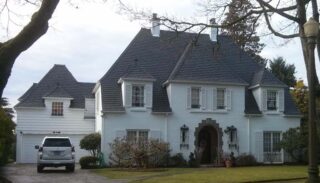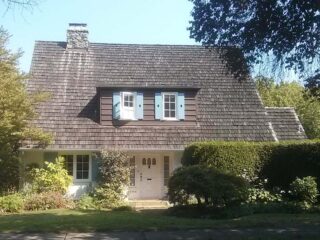Siding of Norman Revival buildings is usually stucco. They may be ornamented with stone or brick elements, and wooden rarely half-timbering. They often have decorative quoins around windows and doors, and sometimes on the corners of the building.
Form
A comparatively rare interwar style found mainly in South Shaughnessy, with stucco walls, tall leaded windows with shutters, quoined corners, quoined arches over front doors, and a prominent, very steep roof that may enclose a hipped-roof turret or have hipped-roof bays protruding from it.
Background
The Norman Revival style emerged after World War I as soldiers returning from the battlefields of France brought back an interest in French architecture. It was inspired by the styles of Normandy, where many soldiers were stationed during the war. The style spread in the 1920s thanks to the publication of photographic studies of French homes, which gave architects and builders access to more models. In Vancouver, homes inspired by the architecture of Normandy are rare. They are mainly found in Shaughnessy and are often larger buildings.
Details
- Steeply pitched hipped roof
- Eaves commonly flared upward at roof-wall junction
- Roof may have hipped-roof turret or have hipped-roof bays projecting
- Tall leaded windows
- Brick, stone, or stucco walls
- No dominant front gable


